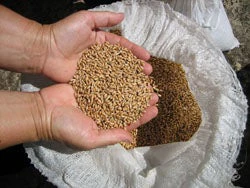The link between trade in agricultural commodities and food security is relatively well studied. Considering the three pillars of food security, food availability (sufficient quantities of food available on a consistent basis), food access (having sufficient resources to obtain appropriate foods), and food use (appropriate use based on knowledge of basic nutrition), trade is seen as a necessary, but not sufficient factor for ensuring food security. How trade and food security link to water and/or how water influences trade and food security has so far been much less explored. An exception are studies on water footprints and international virtual water flows which usually simply “translate” the quantities of agricultural commodities traded into quantities of water that had been necessary to produce them--either in terms of water applied (through rainfall and/or irrigation) or water consumed (crop evapotranspiration). Such studies show, for example, the United States as a major net exporter of virtual water and the MENA region as a big net virtual water importer.
In order to shed more light on the relationship between trade and food security on the one hand and water on the other hand, a workshop was organized on August 30, 2012 as part of the World Water Week in Stockholm. The convenors included the Stockholm International Water Institute (SIWI), King’s College London, and the World Bank. The presentations focused on four levels of analysis: (i) global trends related to cereal and oilseed trade (Carl Hausman, Bunge International); (ii) the importance of managing wheat imports in water-scarce MENA (Don Larson, DEC); (iii) efforts by Morocco to adjust to rising world food prices while ensuring macroeconomic and social stability (Mohamed Ait Kadi, Global Water Partnership);, and (iv) pilots in Ghana and Zambia to support smallholder farmers in benefiting from international trade (Charlotte de Fraiture, UNESDO-IHE). Key messages resulting from the presentations and the panel discussion included:
- Trade, especially in cereals and oilseeds, will grow in importance for complementing local and regional supplies, and for sharing the scarce resource water.
- While cereal and oilseed trade is projected to double by 2050, its share of global production will only slightly increase from 12% to about 15%. Thus, local and regional production of cereals and oilseeds will remain critical. This calls for efforts in better water management locally and regionally, and for providing opportunities for smallholders.
- The concepts of water footprint and virtual water as they are currently being used need to be refined, or at least adjusted by a weighting with water scarcity values, to be more meaningful. Yet the question would still remain whether such measures that focus on just one input in complex production and consumption activities can provide relevant information for guiding decisions on water and water-related trade.
- In order for trade to be a reliable avenue for improving food security and adjusting to water imbalances and uncertainties, progress needs to be made with GATT/WTO and the Doha negotiations to create a system where both imports and exports remain free to flow in good times and bad.
- More collaboration between researchers, governments and the private sector, and more awareness on the part of final consumers, will become increasingly important in managing global strategic natural resources such as water.
Photo credit: Grains, Kosovo, 2008. Photo credits: Susanna Todorovic, SIWI.



Join the Conversation